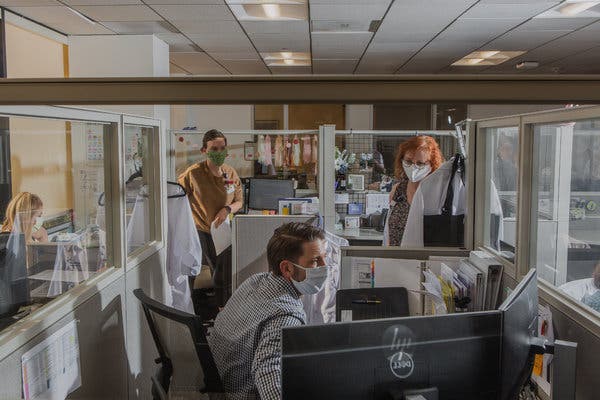I remember when “Workplace Wellness” meant I’d be conducting a series of workshops on health issues to encourage employees to adopt better lifestyle habits at home so that they’d stay healthy and call in sick less often. But now, the focus is on wellness at work so that we can get in and out of our jobs without catching anything and bringing it home.
As we’re being allowed to re-enter the workplace following months in quarantine, we seem to have more questions than answers about how to get back to our office desks safely. It took weeks of practice to adapt to working from home – including creating new schedules, home schooling, frequent snacking, no showering, Zoom meetings and even procrasti-baking. But no one prepared us for the precautions we might need to take to navigate the same office spaces we may have worked in for years. Our offices may never look the same again.
The New Workspace
Elevator buttons on floors, keyless entries, washroom faucets and flushers that work automatically, temperature checking and, of course, mask-wearing are just a few of the modifications we’ll be seeing when we go back to our desks. Employers are working hard to keep us healthy at work, and depending on what state you live in, there may be specific guidelines regarding sanitation procedures and whether you will need to wear a mask at your desk or in communal spaces or both.
But as much as we want to get back to our pre-COVID-19 lives, many of us are skeptical about leaving our shelters. Roseann Capanna-Hodge, psychologist, integrative mental health expert and owner of Dr. Roseann & Associates in Connecticut, coined the term “Re-Entry Panic Syndrome” to capture the emotion we may be feeling when it comes to leaving the security of our homes.
Capanna-Hodge told me that “even people who may not have had a history of anxiety could be feeling panic right now or some level of discomfort about whether their work environment is safe enough for them to return to.”
Getting to Work
Even if our work stations are pristine, we have to feel comfortable with transportation options that will get us to and from our jobs. Capanna-Hodge agrees that “people are worried about public transportation because traveling in close quarters brings a higher risk of catching something.”
If you feel the need to take further precautions when you get home from work, Capanna-Hodge suggests that you “do whatever procedures you need to make yourself feel comfortable, like showering when you get home, which could be a good way to clean your nasal passages. Good hygienic practices can help to reduce transmission of disease and support the immune system to help fight infection and reduce stress levels.”
Taking Precautions in Common Areas
If you enjoyed schmoozing with co-workers around the water cooler, sharing lunches or meeting in the office cafeteria, you may have to hang onto those memories for a while until we can break bread together again. For the time being, eating at your desk or – if you work in an area where you’re able – going outdoors to a park bench will be your best options.
Dr. Jonathan Spero, CEO of InHouse Physicians, a company that helps global corporations implement policies promoting the health and well being of their employees, says, “it’s clear that everyone is taking food very seriously, so it’ll be awhile before you see an office salad bar or a buffet again.”
Spero feels that corporations may have food services bringing in pre-packaged lunches for their employees including individually wrapped foods like sandwiches. He thinks that the typical gathering in your office kitchen and using a communal coffee pot – or microwave or fridge – will be on hold for the foreseeable future. Some companies are permitting foods to be ordered in and dropped off, but only by certain restaurants, without the need for employees to leave their buildings. He recommends bringing your own lunch to work.
Bring Your Own Lunch
So perhaps back to work will start to look more like back to school. It’s likely that lunch may need to be brought in instead of ordered out, so if you’re preparing meals for your kids, it would be wise to put some aside for yourself. Prepping food from home may seem like it’ll take you more time, but it could also save you money and even save some calories by packing less fried, salty and expensive choices than a restaurant meal might bring.
You might have to put down some cash to have the right equipment on hand. Consider lunchboxes that contain freezer packs to keep your food cold, so you’re not keeping them in the communal fridge. In addition, thermoses for a hot meal, coffee or soup can be handy – or a COVID backpack (yes, I’ve seen them) with separate compartments for your containers and your computer.
Pre- or post-quarantine, I have always been a fan of keeping go-to snacks – or emergency lunches – stashed in a desk drawer. A jar of nut butter, whole grain crackers, unsalted nuts, healthy energy bars and dried or freeze dried fruits and veggies could satisfy hunger with a combo of protein, carbs and healthy fats to get you through your day without leaving your desk.
Melissa Altman-Traub, a registered dietitian nutritionist in the Philadelphia area, suggests keeping some items at your desk like, “a coffee pot that can be used for coffee or tea, a mug heater, your own coffee mug, dish soap and dish rag.”
To take a break, Altman-Traub says, “consider online conferences with coworkers from your desk to keep things social – or take a walk outside.” Now that the weather is warmer, perhaps a picnic on a nearby bench while social distancing with a friend could provide a mealtime escape.
Don’t be Mask-Bullied
As we become desensitized to precautions and people start feeling more comfortable sharing space again, they may ditch their distances and stop wearing their masks. But if you’re still on your own high alert and you want to maintain the strategies that keep you feeling secure, don’t let anyone bully you into letting your guard down until you’re ready.
Spero points out that “now until November, we’ll be on a positive trend, where things are going to be getting better and better with business back to a new normal, but around December/January, we’ll see a resurgence of colds and influenza and most likely another, but smaller, wave of COVID.”
Part of this predicted bump is because, by then, restrictions will have further loosened, the weather will be colder and more activities will have moved indoors and cold and flu season kick up.
That time of year will also bring a resurgence of angst, concern and confusion, not knowing whether a sneezing workmate has the flu, a common cold or COVID-19. Hopefully by then we’ll be in a better place to safeguard our workspaces and protect ourselves.
And consider this: If you scrubbed your hands in the washroom, wiped down your keyboard, brought your own packaged lunch and sanitized your workspace, you’ll be on the right track. But what are you going to do when you get a text on your phone while you’re eating? We often overlook the germs that lurk on our electronic BFFs. It’s doubtful that you’ll set an away message during lunchtime, but it might be helpful to eat a meal with a side dish of sanitizing wipes. Keep your phone clean and stay safe.












